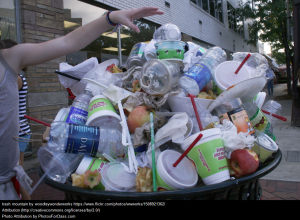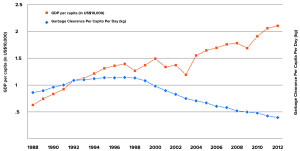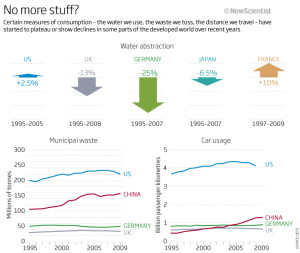Our trash can tell us a lot about ourselves: What magazines we read, how much we love Trader Joe’s frozen pizza, or whether we’ve finally decided to get rid of your parents’ couch from the ‘70s. But, as it turns out, the sum total of our trash, and our neighbors trash, can also tell us a lot about the health of a country’s economy.
This is called the Garbage Index, which looks at the total amount of waste a country produces to measure the health and growth of its GDP.
There are several reasons the amount of trash a country produces would correspond well to a country’s GDP. First, both are directly impacted by large and/or growing populations. The bigger a population, particularly of working age, the more consumers there are, the more trash they will likely produce. The consumption part is also key here, as the amount each person throws away reflects purchasing power and demand for products.
The amount a country is investing in certain projects — particularly those relating to real estate and commercial development — is also reflected in its waste. As economist Mark McDonough explained in an interview with Marketplace in 2012:
“It’s holistic because it’s not isolated to a single part of the economy. It’s people throwing things out, it’s buildings being demolished — it’s everything. … I mean, if you’re going to build a new building, there might be a building that’s already there.”
But while this indicator boasted an 82.4% correlation with the U.S. economy from 2001-2012, there are signs that indicate this relationship may not be so tightly bound going forward — particularly as attitudes towards waste change.
An article in GOOD magazine published late last year analyzes Taiwan’s evolving relationship towards waste — and how it is consciously separating the size of its GDP gains from the size of its landfills. Citing policies implemented in 1988, the Taiwanese government has been able to “decouple GDP growth and production of household waste over a period of about one generation.”
Taiwan has done this through a multi-prong approach that focuses on education (offering environmental lessons from everyone to school children and government officials) and urban planning (less garbage bins in public spaces are thought to make the Taiwanese more aware of the trash they are producing).
As of last year, Taiwan was approaching a robust $40,000 GDP per capita. Meanwhile, the average Taiwanese citizen also produced less than a kilogram of trash per day. Compare this to the average American, who produced roughly two kilos — that is, four pounds — of trash per day.
The following graph, published in the same article, dramatically illustrates the way this relationship has broken apart.
Finally, some economists suggest that the amount that we are capable of consuming has simply plateaued. Numbers from 2012 indicate that municipal waste and car usage have been either steady or on the decline in the U.S. and other developed countries.
However, China is a notable exception. This trend also is not true of other emerging economies.
The article’s author, Fred Pearce, expands on this:
“Even if peak stuff is reached soon, it will only apply to the billion or so people living in rich countries out of the global population of 7 billion. Achieving worldwide peak stuff, critics argue, would require heading off rising demand in the developing world, while seeing a much more sustained fall in consumption among richer nations.”
Currently, there isn’t evidence to support the idea that emerging economies will cease demanding more goods, services, and development — particularly when the idea of “stuff,” and lots of it, is so closely tied to the image of economic prosperity. As the middle class continues to grow throughout Asia and Africa, so will the waste they leave behind. The effects of this waste on the environment clearly present new challenges, both locally and globally, that must be dealt with by citizens, businesses and governments alike.
So, while today’s piles of garbage signal sound economic health for investors and economists, the relationship between garbage and GDP is one the more environmentally conscious among us would like to see laid to waste.



Leave a Reply
You must be logged in to post a comment.